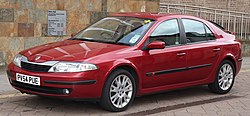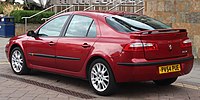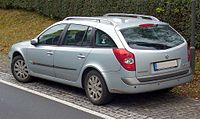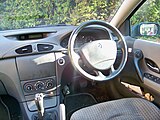Renault Laguna II
| Renault | |
|---|---|
|
Renault Laguna (2001-2005)
|
|
| Laguna II | |
| Sales designation: | Laguna |
| Production period: | 2001-2007 |
| Class : | Middle class |
| Body versions : | Station wagon , station wagon |
| Engines: |
Petrol engines : 1.6-3.0 liters (79-155 kW) Diesel engines : 1.9-2.2 liters (77-127 kW) |
| Length: | 4571-4715 mm |
| Width: | 1772 mm |
| Height: | 1429-1443 mm |
| Wheelbase : | 2748 mm |
| Empty weight : | 1345-1675 kg |
| Previous model | Renault Laguna I. |
| successor | Renault Laguna III |
| Stars in the Euro NCAP - Crash Test (2001) |
|
| Stars in the Euro NCAP - Crash Test (2003) |
|
Renault Laguna II (type G) designates the second generation of the mid-size car Laguna by Renault .
General
- Development code: X74
- planned and constructed in the Renault Technocentre near Paris
- Development time: 42 months
- Development costs: 1 billion euros
- built: March 2001 to September 2007
- Daily quantity: 1600 units
Model history
The completely redeveloped Laguna II appeared in March 2001. The so-called “nose patch” that characterizes it, an element between the bonnet and the radiator grille, is painted silver-gray as standard regardless of the exterior color. The Laguna II was the first car to achieve five stars (33 points = 97%, +1 point for the seat belt warner ) in the Euro NCAP crash test.
The Laguna II was also the first car to receive a chip card instead of a conventional key. This card was available in the versions Keyless Drive and Keyless Entry & Drive . The former had a button each for manually locking and unlocking the vehicle. The Keyless Entry & Drive variant with three buttons (equipment subject to a surcharge, standard from the Privilège variant ) also had an automatic mode. If it was active and the driver approached the vehicle with the chip card, the vehicle recognized the chip card. When a door handle was touched, the vehicle was automatically unlocked (sensor in the recessed grip). If the driver left the vehicle, it was automatically locked again. To start the engine, however, the card had to be inserted into the reader in the center console (release of the steering column lock and deactivation of the immobilizer) and a separate start / stop button had to be pressed in both variants. The keyless drive system was gradually introduced in other model series (including Mégane ) and developed into the hands-free keycard (option in the Laguna III ). This allows the engine to be started without first inserting the chip card into the reader.
Compared to its predecessor, Renault expanded the equipment variants significantly. The basic version was called Authentique and offered, among other things, electric exterior mirrors, electric front windows, on-board computer and air conditioning as standard. Above this was the Expression variant , which also offered power windows at the rear, a leather steering wheel, tilt-adjustable safety headrests and fog lights. The more sporty version Dynamique received sports seats, leather / fabric upholstery and 17 "aluminum wheels. In addition, there was the Privilège equipment, which was almost completely equipped (including automatic climate control, rain sensor and automatically dimming interior mirror) and later even for Privilège Plus was expanded. The top model was the Initiale equipment , which had leather upholstery, xenon headlights and electric seat adjustment and also contained almost everything imaginable as standard, so the list of other extras was correspondingly short.
The engines were the 1.6 and 1.8 l petrol engines with 107 and 120 (later 115) hp, which were already known from the Laguna I. There was also a 2.0-l-16V with 135 PS, which was temporarily replaced by a 2.0-l-16V direct injection (2.0 IDE) with 140 PS, and a 3.0-l-24V with 207 PS (only available with the Proactiv automatic). A turbo version of the 2.0-liter 16V with 163 hp followed later. The diesel engines were the new developments 1.9 dCi (105 PS and 120 PS) and the 2.2 dCi (135, later 150 PS).
The 2.2 dCi turned out to be not very durable, which resulted in engine problems for many Laguna drivers. These quality defects are said to have been remedied by the facelift in spring 2005. For years, the car took the worst place in the breakdown statistics.
Based on the Laguna, the Vel Satis sedan and the Van Espace IV were also manufactured in the French plant in Sandouville from 2002 .
Technical specifications
| 1.6 16V | 1.8 16V | 2.0 16V | 2.0 IDE | 2.0 16V turbo | 3.0 V6 | 1.9 dCi | 2.2 dCi | ||||||
|---|---|---|---|---|---|---|---|---|---|---|---|---|---|
| Construction period | 03/2001–03/2005 | 03 / 2001-10 / 2004 | 01 / 2003-03 / 2005 | 08 / 2002–03 / 2005 | 03/2001–01/2003 | 01 / 2003-03 / 2005 | 03/2001–03/2005 | 08/2004 - 03/2005 | 03 / 2001-08 / 2004 | 03 / 2001–01 / 2002 | 03/2001–03/2005 | 11 / 2004-03 / 2005 | 08 / 2002–03 / 2005 |
| Engine characteristics | |||||||||||||
| Engine type | R4 petrol engine | V6 petrol engine | R4 diesel engine | ||||||||||
| Number of valves per cylinder | 4th | 2 | 4th | ||||||||||
| Valve control | DOHC , timing belt | 2 × DOHC, toothed belt | OHC, timing belt | DOHC, timing belt | |||||||||
| Mixture preparation | Manifold injection | Direct petrol injection | Manifold injection | Common rail injection | |||||||||
| Engine charging | - |
Turbocharger , intercooler |
- |
Turbocharger , intercooler |
|||||||||
| cooling | Water cooling | ||||||||||||
| Engine identification | K4M | F4P | F4R | F5R | F4Rt | L7X | F9Q 664 | F9Q 754 | F9Q 718 | F9Q 670 | G9T | ||
| Bore × stroke | 79.5 x 80.5 mm | 82.7 x 83.0 mm | 82.7 x 93.0 mm | 87.0 x 82.6 mm | 80.0 x 93.0 mm | 87.0 x 92.0 mm | |||||||
| Displacement | 1598 cc | 1783 cc | 1998 cc | 2946 cc | 1870 cc | 2188 cc | |||||||
| Compression ratio | 10.0: 1 | 9.8: 1 | 10.0: 1 | 9.5: 1 | 10.5: 1 | 19.0: 1 | |||||||
| Max. power | 79 kW (107 hp) at 5750 rpm |
88 kW (120 PS) at 5750 rpm |
85 kW (115 PS) at 5750 rpm |
99 kW (135 PS) at 5500 rpm |
103 kW (140 PS) at 5500 rpm |
120 kW (163 hp) at 5000 rpm |
152 kW (207 hp) at 6000 rpm |
68 kW (92 PS) at 4000 rpm |
74 kW (100 PS) at 4000 rpm |
79 kW (107 PS) at 4000 rpm |
88 kW (120 PS) at 4000 rpm |
102 kW (139 PS) at 4000 rpm |
110 kW (150 PS) at 4000 rpm |
| Max. Torque | 148 Nm at 3750 rpm |
170 Nm at 3750 rpm |
168 Nm at 3750 rpm |
191 Nm at 3750 rpm |
200 Nm at 4250 rpm |
270 Nm at 3250 rpm |
285 Nm at 3750 rpm |
230 Nm at 2000 rpm |
200 Nm at 1500 rpm |
250 Nm at 1750 rpm |
270 Nm at 2000 rpm (1) |
320 Nm at 1750 rpm |
320 Nm at 2000 rpm |
| Power transmission | |||||||||||||
| drive | Front wheel drive | ||||||||||||
| Gearbox, as standard | 5-speed manual transmission | 4-speed automatic transmission | 5-speed manual transmission | 6-speed manual transmission | 5- speed automatic transmission | 6-speed manual transmission | 5-speed manual transmission | 6-speed manual transmission | |||||
| Gearbox, optional | - | 4-speed automatic transmission | - | 5-speed automatic transmission | |||||||||
| Readings | |||||||||||||
| Top speed | 195 km / h | 203 km / h | 190 km / h | 205 km / h with automatic: 200 km / h |
210 km / h | 218 km / h | 235 km / h | 180 km / h | 185 km / h | 193 km / h | 200 km / h | 210 km / h | 215 km / h with automatic: 208 km / h |
| Acceleration, 0-100 km / h | 11.5 s | 10.8 s | 12.9 s | 9.9 s with automatic: 12.1 s |
9.8 s | 8.5 s | 8.1 s | 14.2 s | 13.0 s | 12.3 s | 10.7 s | 9.8 s | 9.8 s with automatic: 10.9 s |
| Fuel consumption over 100 km (combined) | 7.2 l p | 7.6 l p | 8.3 l p | 7.9 l S with automatic: 8.4 l S |
7.7 l p | 8.2 l p | 10.1 l p | 5.6 l D | 5.4 l D | 5.6 l D | 7.2 l D | 6.8 l D | 6.5 l D with automatic: 7.6 l D |
| Remarks | |||||||||||||
| not for E10 fuel suitable | |||||||||||||
- The availability of the engines depended on the model, equipment and market.
Facelift
In April 2005 the Laguna II was revised (phase II). The most striking feature is the adaptation of the front to the brand face, which is why the "nose patch" was omitted. The main focus at Renault was improving the quality of the interior materials as well as the mechanics and electronics.
In the interior, safety headrests for children were installed for the first time . The headrests on the rear seats can be opened. Behind it there are two laterally padded supports, which serve as head and neck supports on the one hand, and as protection against the head jumping back and forth too quickly in the event of a collision on the other.
The chip card for opening and starting the car has been improved. It was no longer necessary to insert the card into the slot to start, as it could remain in the driver's pocket. There was also a new Carminat 3 DVD navigation system , which was controlled via a central control element in the center console (similar to the Audi MMI). Space for this was created by eliminating the normal handbrake , which was now operated electrically. The navigation system was able to display important parts of the route (for example, dividing motorways) in 3D, so that the driver can recognize at an early stage which lane to follow.
The basic version was called emotion ; Before the facelift, this name had been used for a special model of the Laguna II, the Privilège Plus line was changed back to Privilège . There is also a sports version called the GT . The drive is the 2.0 turbo, which has been upgraded to 204 hp (almost identical to the 225 hp engine from the Mégane RS). In addition to a tighter sports suspension with a lowering of 10 mm, the interior with black and red leather cover and red decorative stitching has been optically adapted to the performance. Special 17 "alloy wheels and the special color Curacao blue are also available.
With the facelift, the 1.6 and 1.8 l petrol engines of Phase I were replaced by the 1.6 16V with 82 kW (112 hp) already known from the Mégane. In addition, the output of the 2.0 16V Turbo has been increased to 125 kW (170 PS). Renault equipped the 1.9 dCi with a soot particle filter and was offered in the output levels 81 kW (110 PS) and 96 kW (130 PS). The 2.2 dCi was throttled from 110 kW (150 PS) to 102 kW (139 PS).
From the beginning of 2007 there was an additional expansion stage of the 2.0 dCi with 127 kW (173 PS) as well as a new 6-speed gearbox that emerged from the cooperation with Nissan .
Technical specifications
| 1.6 16V | 2.0 16V | 2.0 16V turbo | 3.0 V6 | 1.9 dCi | 2.0 dCi | 2.2 dCi | ||||||
|---|---|---|---|---|---|---|---|---|---|---|---|---|
| Construction period | 04 / 2005-09 / 2007 | 08/2005-09/2007 | 01 / 2006-09 / 2007 | 04/2005–01/2006 | 01 / 2006-09 / 2007 | |||||||
| Engine characteristics | ||||||||||||
| Engine type | R4 petrol engine | V6 petrol engine | R4 diesel engine | |||||||||
| Number of valves per cylinder | 4th | 2 | 4th | |||||||||
| Valve control | DOHC , timing belt | 2 × DOHC, toothed belt | OHC, timing belt | DOHC, timing belt | ||||||||
| Mixture preparation | Manifold injection | Common rail injection | ||||||||||
| Engine charging | Turbocharger, intercooler | Turbocharger , intercooler | ||||||||||
| cooling | Water cooling | |||||||||||
| Engine identification | K4M | F4R | F4Rt | L7X | F9Q | M9R | G9T | |||||
| Bore × stroke | 79.5 x 80.5 mm | 82.7 x 93.0 mm | 87.0 x 82.6 mm | 80.0 x 93.0 mm | 84.0 x 90.0 mm | 87.0 x 92.0 mm | ||||||
| Displacement | 1598 cc | 1998 cc | 2946 cc | 1870 cc | 1995 cc | 2188 cc | ||||||
| Compression ratio | 9.8: 1 | 9.5: 1 | 9.0: 1 | 10.9: 1 | 18.3: 1 | 17.0: 1 | 16.0: 1 | 18.0: 1 | ||||
| Max. power | 82 kW (112 hp) at 6000 rpm |
99 kW (135 PS) at 5500 rpm |
125 kW (170 PS) at 5000 rpm |
150 kW (204 PS) at 5000 rpm |
152 kW (207 hp) at 6000 rpm |
81 kW (110 PS) at 4000 rpm |
96 kW (130 PS) at 4000 rpm |
110 kW (150 PS) at 4000 rpm |
127 kW (173 hp) at 3750 rpm |
110 kW (150 PS) at 4000 rpm |
102 kW (139 PS) at 4000 rpm |
|
| Max. Torque | 151 Nm at 4250 rpm |
191 Nm at 3750 rpm |
270 Nm at 3250 rpm |
300 Nm at 3000 rpm |
280 Nm at 3750 rpm |
260 Nm at 2000 rpm |
300 Nm at 3000 rpm [250 Nm / 1600min] |
340 Nm at 2000 rpm |
360 Nm at 1750 rpm |
320 Nm at 1750 rpm |
||
| Power transmission | ||||||||||||
| drive | Front wheel drive | |||||||||||
| Gearbox, as standard | 5-speed manual transmission | 6-speed manual transmission | 5- speed automatic transmission | 6-speed manual transmission | ||||||||
| Gearbox, optional | - | 4-speed automatic transmission | 5-speed automatic transmission | - | 4-speed automatic transmission | - | 5-speed automatic transmission | |||||
| Measured values (limousine) | ||||||||||||
| Top speed | 197 km / h | 207 km / h with automatic: 202 km / h |
223 km / h with automatic: 219 km / h |
235 km / h | 194 km / h | 204 km / h with automatic: 200 km / h |
215 km / h | 225 km / h | 215 km / h with automatic: 212 km / h |
210 km / h with automatic: 207 km / h |
||
| Acceleration, 0-100 km / h | 11.5 s | 9.8 s with automatic: 12.3 s |
8.4 s with automatic: 9.0 s |
7.2 s | 8.0 s | 12.3 s | 10.2 s with automatic: 12.2 s |
8.9 s | 8.4 s | 9.8 s with automatic: 10.3 s |
9.8 s with automatic: 10.0 s |
|
| Fuel consumption over 100 km (combined) | 7.4 l S | 7.9 l S with automatic: 8.6 l S |
8.4 l S with automatic: 9.0 l S |
8.5 l S | 9.9 l p | 5.5 l D | 5.9 l D with automatic: 6.9 l D |
6.0 l D | 6.5 l D with automatic: 7.6 l D |
6.8 l D with automatic: 7.6 l D |
||
| Measured values (Grand Tour) | ||||||||||||
| Top speed | 194 km / h | 204 km / h with automatic: 199 km / h |
220 km / h with automatic: 216 km / h |
232 km / h | 191 km / h | 201 km / h with automatic: 197 km / h |
212 km / h | 222 km / h | 212 km / h with automatic: 205 km / h |
207 km / h | ||
| Acceleration, 0-100 km / h | 11.8 s | 10.1 s with automatic: 12.5 s |
8.6 s with automatic: 9.2 s |
7.4 s | 8.2 s | 12.6 s | 10.5 s with automatic: 12.5 s |
9.2 s | 8.8 s | 9.8 s with automatic: 10.5 s |
10.0 s with automatic: 10.5 s |
|
| Fuel consumption over 100 km (combined) | 7.7 l p | 8.2 l S with automatic: 8.7 l S |
8.5 l S with automatic: 9.3 l S |
8.6 l S | 10.1 l p | 5.5 l D | 6.3 l D with automatic: 6.9 l D |
6.0 l D | 6.2 l D | 6.5 l D with automatic: 7.6 l D |
6.9 l D with automatic: 7.7 l D |
|
| Others | ||||||||||||
| Emission standard | Euro 4 | Euro 3 | ||||||||||
- The availability of the engines depended on the model, equipment and market.
literature
- Automobile revue . Catalog 2001, 2003, 2005 and 2007.
Web links
Individual evidence
- ↑ The Laguna II in the Euro NCAP crash test, 2001 (accessed on May 29, 2014, English)
- ↑ The Laguna II in the Euro NCAP crash test, 2003 (accessed on May 29, 2014, English)
- ↑ Construction time ( memento of the original from September 26, 2014 in the Internet Archive ) Info: The archive link was inserted automatically and has not yet been checked. Please check the original and archive link according to the instructions and then remove this notice.
- ↑ Breakdown statistics - autobild.de
- ↑ List of Renault car models not suitable for E10
- ↑ Safe headrests







